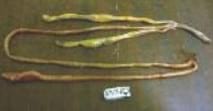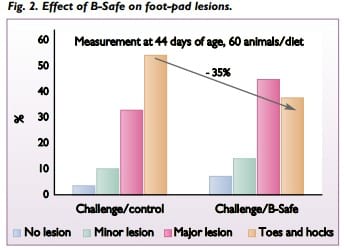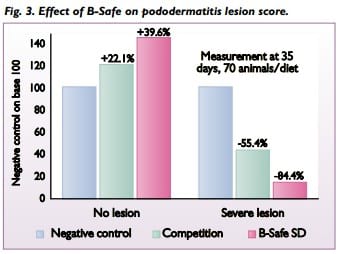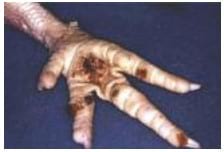热度 3 |||





The gut microflora is part of the digestive system and influences FCR and the economic performance of broilers. It is, therefore, very important to investigate its composition to better understand if and how we may positively influence it.
According to different authors, we only know 10-25% of total poultry gut microflora. Indeed all micro-organisms have not yet been identified by conventional methods. Thus, not neglecting traditional methods, DNA based approaches have been developed, in order to clarify the total profile of gut flora.
Many research teams are actually working on either qualitative (DNA fingerprinting methods: 16SrRNA gene target) or even quantitative methods (Fish, q PCR) to better type microflora in different parts of the poultry gut or to characterise changes in
poultry gut flora caused by different factors, such as the occurrence of pathogenic zoonotic bacteria, or the use of feed additives.
We know that poultry microflora is made up of approximately 30 different genus gathering not less than 600 species. Thus, when talking about the importance and influence of gut microflora, remember that the number of bacterial cells in the host is 10 times the eukaryote cell number in the bird’s body or that their genes number is 50-100 times higher than the total number of genes constituting the host!

Intestinal distortions caused by dysbacteriosis
The gut of the broiler is sterile at birth and the establishment of digestive flora will depend on the species present at hatch and in the first days of life. Coliforms, streptococci, clostridia and bifidobacteria colonise the intestine very rapidly. Lactobacilli appear only after 3-4 days. The stabilisation of gut microflora would take two weeks in the intestine and at least 4-6 weeks in the caeca.
Of course this ‘normal’ process may be influenced by numerous factors, such as environment (broilers on the floor will be more in contact with bacteria than broilers in a cage) and stress (heat, mycotoxins, coccidiosis, density, vaccination) that will reduce their defences.
Since bacterial species differ from each other according to their substrate preference and growth requirement, the chemical composition and structure of the digesta largely influences the species distribution in gut.
This ecosystem impacts the host in various ways. First on the physiology of the digestive tract by increasing intestinal length and improving gut wall thickness, microflora thus improves gut integrity. In fact, it produces fuel for gut wall enterocyte (volatile fatty acids) and favours mucus production.
Then it plays a great role in poultry health. Microflora can either act negatively by producing toxic metabolites such as biogenic amines by degrading proteins, inflammatory molecules as histamine, endotoxins from their wall and can even retoxify compounds detoxified by the liver.
On the other hand, they also produce beneficial metabolites such as vitamins. They also play the fundamental ‘barrier flora’, preventing pathogens from colonising the digestive tract.
Finally, taking into account that 70% of the immune system of poultry is located in the intestinal tract and that 25% of the intestinal mucosa is lymphoid tissues, we can easily imagine that gut micro-flora may influence the immune system. In fact, the microflora acts both as an antigen source and as a nonspecific immunomodulator.
In conclusion, the gut microflora profile, localisation and composition is influenced by many different factors in which diet composition seems to dominate and may influence the host in terms of gut tract physiology, immune system and health, and thus the economic performance of the flock


To maintain a good flora balance by preventing so called dysbacteriosis is the target.
Since the ban of antibiotic growth promoters (AGPs) in Europe and now in some other countries all over the world (recently South Korea), the incidence of dysbacteriosis problems has increased. Subclinical gut problems, such as liquid and mucous laden grey to orange faeces, pododermatitis, intestinal distortion and breast lesions, can occur. An increase in the prevalence of foodborne pathogens is also said to be linked to those dysbacteriosis.
Neovia has been working for almost 10 years to develop B-Safe, a sustainable and reliable AGP substitute aiming at securing the digestive process, preventing any imbalance in the gut microflora. B-safe is based on an unique ion exchanged technology bringing to the product high antimicrobial potency against various pathogens.
Trial results
Many performance trials set up under challenging conditions (poor sanitary status environment, density, inoculation of pathogens) to mimic field conditions or also simply in real field conditions with high numbers of animals have demonstrated the reliable efficacy of B-Safe on growth rate (+3.2% on average) and on FCR (-3% on average).

Pododermatitis
More targeted trials have also demonstrated the potential of the product to reduce dysbacteriosis problems (bacteria excretion in faeces and pododermatitis lesions).
As an example, a trial was set up with a poultry integrator. Broilers from farms positive for campylobacter were brought to the R&D station to be fed with the control diet or the B-Safe diet for two weeks.
Evolution of the gut bacteria profile between the beginning and the end of the trial was individually evaluated for each animal by sampling individual faeces and microbial measurements.
It demonstrated that the commensal flora (lactobacillus) was not harmed by the treatment. On the contrary, B-Safe allowed reduction of campylobacter and clostridia prevalence in the gut (approximately 1 log), while at the same time reducing individual variation (100% of the birds in the B-safe group have reduced their clostridium excretion).
As litter quality evaluation is very subjective, different trials were set up for evaluating the incidence of the use of B-Safe on the pododermatitis lesion score of broilers.
The first trial compared the control diet and the B-Safe diet in high challenging conditions (increased bird density and viscosing diet) generating performance losses on control animals (-7% ADG and +10% FCR) and high incidence of pododermatitis. In this context, B-Safe reduced the number of severe foot pad lesions (toes and hocks) by 35%.
A second trial followed by R&D in standard farm conditions confirmed the benefits of using B-Safe on pododermatitis incidence together with improvement of zootechnical performances (+2.7% ADG, -2.8% FCR).
B-Safe reduced the number of birds with severe lesions from 18% in the control group to less than 3% in the treated group (-84%).
In conclusion, gut management is of high importance to optimise physiological and economic performance. Among other things, nutrition and feed additives can play a strong role.
B-Safe is a promising feed additive to prevent dysbacteriosis, and consequently wet litter and pododermatitis, and to secure the digestive process to boost performances.